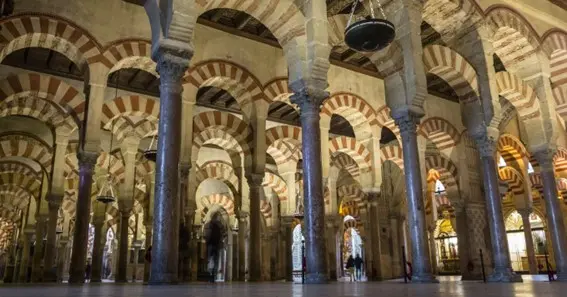Spain has a very rich history that has left behind many amazing old buildings and sites. To truly experience and witness the remarkable grandeur of these historical places, a visit to Spain’s historical sites is a must. These sites give you the chance to go back in time and uncover the stories behind every arched doorway and intricately carved stone.
As you visit and explore these landmarks, you’ll realize it’s about more than just admiring impressive structures. It’s about connecting with the true essence of a nation’s past and understanding the triumphs and struggles that shaped its identity over hundreds of years.
Navigating new cities and understanding layers of history can be tough, but this article will guide you, telling the tales behind each site so you can truly appreciate every moment.
Standing at the spectacular Alhambra in Granada, an incredible Moorish palace, will make you feel like you’ve traveled back to an era of lavish lifestyles and skilled artistry.
Walking through Barcelona’s Gothic Quarter, the echoes of medieval life will surround you with every old cobblestone street. Such experiences ignite curiosity, challenge preconceptions, and offer new perspectives.
In this article, let’s explore Spain’s historical sites together, where past and present intertwine, and the story of how this nation was shaped comes alive right before your eyes.
Barcelona: Modernist Marvels from Gothic Gems
Visiting Barcelona means getting to see some cool buildings and places, like the Sagrada Familia and Park Güell, which were designed by a famous architect named Antoni Gaudí. As you wander from the iconic Sagrada Familia to the whimsical Park Güell, you’re immersed in a city that seamlessly weaves the past with the avant-garde.
However, exploring Barcelona’s treasures independently can be challenging, from crafting the perfect itinerary to fully grasping the stories behind each landmark. This is where the expertise of trip planners becomes invaluable to you. And for those of you dreaming of extending this unforgettable journey, weaving these experiences into luxury Portugal vacations can magnify the splendor of your Iberian adventure. This approach transforms your trip into a seamless tapestry of cultural richness, marrying the allure of Barcelona with the opulence of luxury, tailored specifically for you.
Also Read N: Hidden Hazards in Your OT: Cyber Threats for Established Industries
Park Güell: A Whimsical Wonderland
Your exploration of Gaudí’s Barcelona would not be complete without a visit to Park Güell, a whimsical garden complex that seamlessly blends nature and architecture. Commissioned as a residential project but later transformed into a public park, this UNESCO World Heritage site is a true testament to Gaudí’s imagination and his love for organic forms.
In 2022, Park Güell welcomed over 4.7 million visitors, making it one of the city’s most popular tourist attractions. As you wander through the park’s winding paths and terraced gardens, you’ll encounter a kaleidoscope of colorful mosaics, undulating stone benches, and surreal architectural elements that seem to defy the laws of gravity.
The iconic serpentine bench, adorned with vibrant trencadís mosaics, offers you stunning panoramic views of the city. It serves as a popular gathering spot for visitors and locals alike. One of the park’s most captivating features is the Hypostyle Room, a forest of stone columns topped with intricately designed ceilings that create a mesmerizing play of light and shadow. This space once intended as a marketplace, now stands as a testament to Gaudí’s ingenious use of natural forms and his ability to blend functionality with artistic expression.
Also Read P: What to Buy During Black Friday this 2023
The Gothic Quarter: Medieval Charm Meets Modernity
While Gaudí’s masterpieces may steal the spotlight, Barcelona’s Gothic Quarter is a captivating time capsule that will transport you to the city’s medieval past. Wander through the labyrinth of narrow, winding streets, where centuries-old buildings adorned with intricate Gothic facades stand shoulder to shoulder with chic boutiques and trendy cafes.
At the heart of this historic district lies the Cathédrale de la Santa, a stunning Gothic cathedral that dates back to the 13th century. Marvel at its imposing façade, adorned with intricate stone carvings and towering spires that reach towards the sky.
Step inside, and you’ll be greeted by a breathtaking interior bathed in the warm glow of stained-glass windows, with ornate columns and vaulted ceilings that evoke a sense of awe and reverence.
As you explore the Gothic Quarter, keep an eye out for hidden gems like the Plaça del Rei, a picturesque square surrounded by medieval palaces and the remnants of Roman walls. Stop for a leisurely café con leche in one of the cozy plazas, and soak in the vibrant energy of this historic neighborhood, where the past and present seamlessly intertwine.
The Alhambra
A Moorish Jewel in Granada Perched atop a hill in the historic city of Granada, the Alhambra stands as an awe-inspiring testament to the golden age of Moorish rule in Spain. This magnificent complex, a UNESCO World Heritage site, is a true architectural marvel that has captivated visitors for centuries.
The Alhambra received 721,972 visitors in June, July, and August, exceeding the figures for summer 2022 by 6.3%, making it one of Spain’s most popular tourist destinations and a potential highlight for those embarking on a Custom Tour Portugal that incorporates the historical gems of Spain.
As you wander through the Alhambra, be sure to take a moment to appreciate the incredible craftsmanship and attention to detail that went into creating this Moorish masterpiece. From the intricate tilework to the delicate stucco carvings, every element is a testament to the skill and artistry of the Nasrid builders and craftsmen who left an indelible mark on the history of Spain – a heritage that can be explored as an extension of your Portugal Trips. The chart presented below represents the visitors to major historical sites in Spain.
The Nasrid Palaces: A Jewel Box of Moorish Art
The crown jewel of the Alhambra is undoubtedly the Nasrid Palaces, a series of interconnected buildings that showcase the pinnacle of Moorish art and architecture. As you wander through the lavish halls and courtyards, you’ll be mesmerized by the intricate stucco carvings that adorn the walls, ceilings, and archways.
The Courtyard of the Lions is a true masterpiece, featuring a stunning marble fountain with twelve lions spouting water into a central basin. The surrounding arched galleries are adorned with intricate muqarnas (honeycomb-like carvings) and calligraphic inscriptions that evoke the grandeur and refinement of the Nasrid rulers.
As you explore the palaces, be sure to visit the Sala de los Abencerrajes (Hall of the Abencerrages), where the play of light and shadow through the intricately carved arches creates a mesmerizing atmosphere. The nearby Sala de las Dos Hermanas (Hall of the Two Sisters) is equally breathtaking, with its iconic marble lions and exquisite tilework that showcases the pinnacle of Moorish craftsmanship.
The Generalife Gardens: An Oasis of Tranquility
Your visit to the Alhambra would not be complete without a stroll through the Generalife Gardens, a lush oasis that served as the summer retreat for the Nasrid rulers. Wander through the meticulously manicured gardens, where fountains and water channels create a soothing ambiance, and fragrant flowers and cypress trees offer you respite from the Andalusian sun.
The Patio de la Acequia (Courtyard of the Water Channel) is a highlight of the gardens, with its central pond and elegant arched pavilion that reflects perfectly in the still waters. Nearby, the Jardín de la Sultana (Sultana’s Garden) offers a tranquil escape, with its intricate parterres and secluded nooks perfect for your quiet contemplation.
As you wander through the Alhambra, be sure to take a moment to appreciate the incredible craftsmanship and attention to detail that went into creating this Moorish masterpiece. From the intricate tilework to the delicate stucco carvings, every element is a testament to the skill and artistry of the Nasrid builders and craftsmen who left an indelible mark on the history of Spain.
Conclusion
Spain’s historical sites offer a captivating journey through time, from the exquisite Moorish palaces like the Alhambra in Granada to the ancient Roman ruins such as the Theatre in Mérida. Each site tells a unique story of the diverse cultures that have flourished on Spanish soil.
The Sagrada Familia and Park Güell in Barcelona showcase modernist genius, while the Mezquita in Córdoba reflects Islamic architectural splendor. Visiting these sites, one appreciates the rich tapestry of Spain’s history, where every stone and mosaic piece narrates the legacy of conquerors, architects, and artists who shaped this vibrant nation.
FAQs
- What is the history of the Moors in Spain?
The Moors were North African Muslims who invaded Spain in 711 AD, establishing a presence that lasted until 1492. Their rule introduced significant cultural and technological advancements to the Iberian Peninsula.
- What is Moorish architecture in Spain?
Moorish architecture in Spain is characterized by ornate tile work, horseshoe arches, intricate carvings, and lush gardens, exemplified by landmarks such as the Alhambra in Granada.
- Is there a Moorish castle or palace in Spain?
Yes, the Alhambra in Granada is a renowned Moorish palace, showcasing the epitome of Islamic art and architecture in Spain.
- Where was the Moorish capital of Spain?
The Moorish capital of Spain was Córdoba, which became a center of education and culture, housing the grand Mosque-Cathedral of Córdoba.






